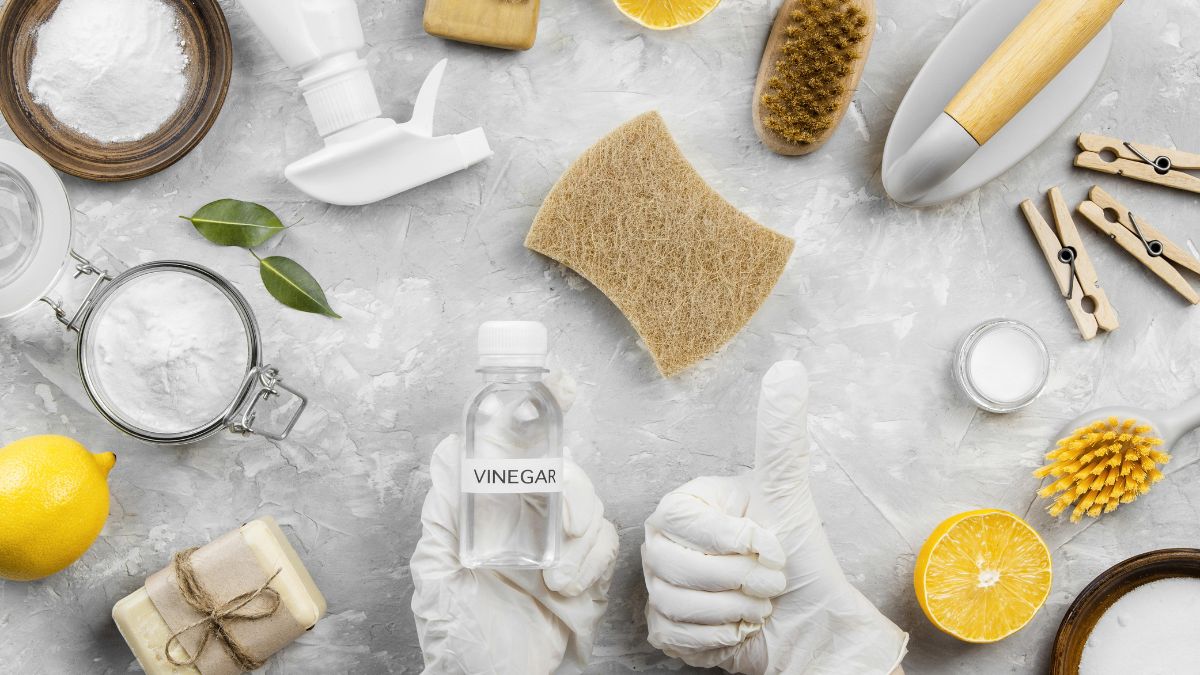There are several eco-friendly cleaning methods that won’t sacrifice a spotless home for the sake of a healthy atmosphere. In this post, we’ll go over many green cleaning strategies that can not only make your home more sanitary but also benefit the environment.
Natural Cleaning Products: Embrace the Power of Nature
Conventional cleaning supplies frequently have toxic chemicals that are bad for people and the planet. Fortunately, there are several non-chemical options that do just as good a job of keeping the house tidy. Vinegar, baking soda, lemon juice, and essential oils are just a few of the many ingredients with potent cleaning characteristics.
Reduce, Reuse, Recycle: Minimize Waste
Waste minimization is an essential part of eco-friendly cleaning. Switching from single-use cleaning supplies like paper towels and wipes to more sustainable options is something to think about. For example, dust and filth are easily captured by microfiber towels, which can then be cleaned and reused several times.
Cleaning product containers and packaging may be recycled to keep them out of landfills and improve environmental quality.
Sustainable Cleaning Tools: Choose Wisely
Using environmentally friendly cleaning supplies may make a big impact. Bamboo is a great example of a rapidly replenishing and long-lasting material that you should seek in your product purchases.
Cleaning tools made from bamboo are long-lasting and biodegradable, making them more eco-friendly. In addition, picking durable cleaning equipment decreases the frequency with which items need to be discarded in landfills.
Water Conservation: Be Mindful of Your Usage
Water conservation is a crucial part of eco-friendly housekeeping. Turning the water off while brushing your teeth or doing the dishes can save several gallons of water daily. Use a spray bottle or a mop with a built-in reservoir to regulate the quantity of water you use when cleaning.
In addition, you may reduce the amount of drinking water you need for outdoor cleaning by collecting and recycling rainwater.
Energy-Efficient Cleaning: Reduce Your Carbon Footprint
Using power-hungry cleaning devices like washing machines and vacuum cleaners may add up quickly. Choosing more efficient models not only helps you save money on power costs but also lessens your impact on the environment.
The Energy Star program rates appliances based on their ability to reduce energy use without sacrificing performance, so look for those with the highest ratings. Using cleaning equipment with a low energy footprint helps the planet and the future.
Indoor Air Quality: Keep Your Home Fresh and Clean
A healthy home environment relies on having high-quality indoor air. Common household cleaners often release VOCs into the air, which can be toxic. Choose non-toxic, chemical-free cleaning supplies to protect the health of you and your loved ones. Air-purifying plants, consistent dusting, and enough ventilation are all ways to enhance the quality of indoor air and boost health.
Green Laundry Practices: Sustainable Washing
Adopting green techniques in the laundry room may have a major effect on the environmental footprint of a home. Choose biodegradable detergents that are also devoid of phosphates and chlorine bleach if you want to be kind to the environment.
Clothes that are washed in cold water retain their colors better and use less energy. Instead of using the dryer all the time, line-drying your clothing saves electricity and leaves them smelling fresh from the outdoors.
Eco-Friendly Pest Control: Natural Solutions
Pest control might be difficult, but using dangerous chemicals should be a last choice. Consider alternative methods of pest management that won’t put your family or the planet in danger. Examples of non-toxic methods of pest control include closing gaps and crevices, minimizing clutter, and making use of natural repellents like essential oils.
FAQs about Green Cleaning: Eco-Friendly Tips for a Cleaner Home
Why should I switch to green cleaning products?
Cleaning using environmentally friendly materials is good for you and the planet. Chemicals included in many common household cleaners are toxic if breathed or absorbed via the skin.
Green cleaning solutions, on the other hand, are safer for you, your family, and the environment because they are manufactured with natural materials and lack hazardous chemicals.
Are natural cleaning products as effective as traditional ones?
Natural cleaning solutions have the potential to be as effective, if not more so, than their synthetic counterparts. Vinegar, baking soda, and lemon juice are three examples of ingredients with potent cleaning capabilities that may be put to use in a wide range of cleaning situations, from sanitizing surfaces to removing stains and smells.
How can I reduce waste while cleaning?
One of the key principles of “green cleaning” is minimizing waste. Recycling cleaning product containers and packaging is another way to lessen an organization’s carbon footprint.
How can I conserve water during the cleaning process?
Sustainable cleaning relies on water conservation. Turning off the water while you wash dishes or brush your teeth is a simple way to conserve water. If you use a mop or spray bottle with a built-in reservoir, you can regulate the quantity of water you use.
Can green cleaning practices improve indoor air quality?
The answer is yes, green cleaning methods can assist enhance IAQ. The volatile organic compounds (VOCs) released by many common household cleaning products contribute to poor air quality and may even create health problems for people with sensitive respiratory systems.
Final Words
Cleaning with these eco-friendly methods not only helps you and your family live in a cleaner, safer space, but it also benefits the earth. The term “green cleaning” refers to a method that combines efficient cleaning techniques with a concern for the environment.
- Key Strategies to Mitigating risks in Rental Property Investments
- The Essential Role of Property Management Companies
- The Ultimate Guide to Handling Evictions and Tenant Conflicts
- The Hidden Impact of Taxes and Insurance Costs
- Protect Your Property: Essential Practices for Effective Tenant Screening

